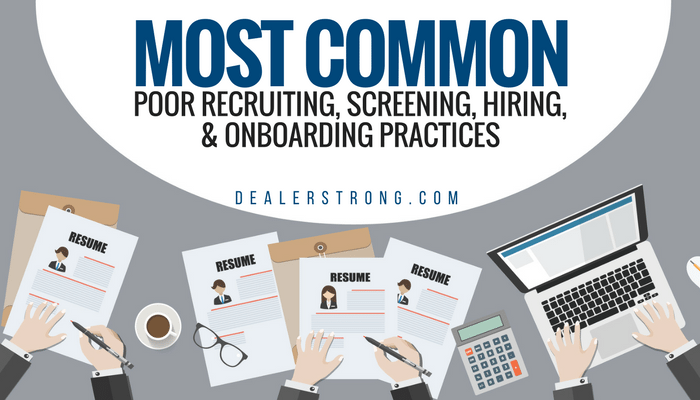Last week I covered the underlying reasons of why the retail automotive tenure at termination is so low. To recap, the turnover for Business Development Representatives (BDR’s) and sales personnel is about 70%, with only 22-35% staying more than three years.
Why, you may ask? There are two primary reasons. If your dealership median tenure at termination is significantly higher, you may have an engagement and retention problem. You would need to spend some time evaluating why you are losing them much further in the employment process. Are they staying engaged at work, do you lose many at a specific time in tenure?
If your dealership’s median tenure is significantly lower (if that’s even possible for BDR’s and sales personnel) you likely have poor recruiting, screening, hiring, or onboarding practices in your store. Could be all four. You simply have a broken system, which given the right attention can likely be fixed.
Those systems can be fixed by first recognizing the problem, so here are the most common poor recruiting, screening, hiring and onboarding practices:
Manager’s hiring without training
First, there is the practice of letting your department managers hire all of their own people without providing them a structured process to follow or training to do it well. That’s a significant issue. As I said before, many of the manager’s interview like they have been interviewed, which is poor in many cases. They haven’t been coached on what to listen for in the interview.
If you are large enough to have a full-time HR generalist on staff my guess is they spend most of their time on keeping up with daily HR demands. Sometimes, they do very early stage recruiting by placing ads or the very late stage processing of background checks or drug screens, but spend very little time dedicated to perfecting the interviewing process for the many positions your organization.
Biases in the hiring process
We are all human. We have biases to some degree. To believe otherwise is ridiculous. The issue is being aware of it enough to put checks and balances in place to help compensate for it. If your sales team is all 30-yr-old black men or 50-year-old white men, you probably have biases in the hiring process. Your bias might be you won’t consider anyone who hasn’t been in the industry before. Conducting reviews of your screening and interviewing process along with final hires is a good way to keep this in check.
Not planning long-term training for success
We hire and set up initial onboarding and it may include a few days or a few weeks of initial training, but that is where it drops off a cliff in many stores. If we want our people to continue to grow, we must place importance on ongoing training for success. Employees want to get better at their jobs. They want to be trained but if you put on the importance on it, most will put little to no focus on it. What training is needed for a salesperson to become a great sales manager then move to a general sales manager? We fail to plan for that success from the beginning.
Inconsistent screening process
Inconsistent screening process problems abound. You or your managers interview 15 people for a position and go about it 15 different ways. Sometimes it’s based on how busy you are when the applicant shows ups. Others, it’s based on how much the candidate mirrors your personality (you will spend more time with those you like). You may even ask mundane superficial questions that have no relevance on if the person can do the job or not. Regardless it’s that lack of a consistent screening process that hinders most hiring processes.
This is where I want to focus your attention. I want to help you consistently be uncovering the best candidates for your store. To do so base your screening process on uncovering the CMETRICS. Next week I’ll dig a little deeper into those CMETRICS. If you missed part one, click here to catch up!

